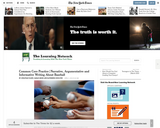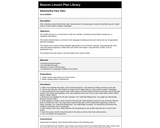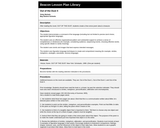
In this lesson, students create and use mixed up one-word poetry cards to write short, vivid poems.
- Subject:
- English Language Arts
- Material Type:
- Lesson Plan
- Provider:
- Beacon Learning Center
- Author:
- Beacon Learning Center
- Date Added:
- 04/23/2019

In this lesson, students create and use mixed up one-word poetry cards to write short, vivid poems.

Students will read a tsunami myth based in Japan. They will analyze the effect of the setting on character and plot details. Then, they will rewrite the myth to take place in an alternative location.

For this lesson, students will learn how to write a mystery. They will be given a list of Nursery Rhymes and asked to create a mystery from the Nursery Rhyme. For example, Did Humpty Dumpty really fall off the wall or was he pushed? They will create a comic from their mystery.

Students will ask and record questions as they reflect upon the work of art. They will develop understanding of metacognition while considering questions and themes. ESSENTIAL QUESTION: How does asking questions lead to deeper thinking?

This lesson plan provides a selection of writing prompts for students to choose from, centered around baseball.

A collection of narrative essay activities.

A collection of narrative essay writing prompts and ideas for varying levels.

After organizing their thoughts using a graphic organizer, students write a narrative essay which relates an autobiographical incident. Students present their essays in a slideshow which allows their classmates to practice predicting an outcome as they guess the ending of the narrative. Some of the essays will be included in a class newsletter created by the students.

What should a good narrative contain? For this lesson, a mystery, a type of narrative realistic fiction, will be composed. Since strong adjectives and adverbs will support a mystery, they will be incorporated into the writing.

In this lesson, students write and share a poem after taking a nature walk for inspiration.

In this unit, students will begin by building their background knowledge in the area of child mortality and maternal health. They will use this knowledge to participate in a narrative research project, focusing on a case study and country of their choice. Finally, students will use this information to complete a Global Advocacy Project.

In this lesson, students choose a newspaper article and dramatize it in a poem.

In this lesson, after reviewing several familiar fairy tales, students work in small groups to rewrite the familiar story as it might read as a news article in today's newspaper.

While Paul Revere's ride is the most famous event of its kind in American history, other Americans made similar rides during the Revolutionary period. After learning about some less well known but no less colorful rides that occurred in other locations, students gather evidence to support an argument about why at least one of these "other riders" does or does not deserve to be better known.

In this video resource from PBS Learning Media, students will consider Mark Twain as the enormous "noticer" and explore the humor that Twain found in the ordinary details of life.

In this lesson, students choose two experiences or images from a given list and write about it using sensory details.

In this lesson, students listen to excerpts about a blind man's journey up Mt. Everest, then write a bio-poem about him.

Students work with primary documents and latter-day photographs to recapture the experience of traveling on the Oregon Trail.

In this lesson, after reading the novel Out of the Dust, students will create a free-verse poem about a treasure.

In this lesson, students read the novel "Out of the Dust" and create an autobiographical poem using figurative language.